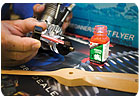

It was a pleasure to meet company founder Richard B. Wallace, who began the company in 1955 as the Nylok-Detroit Corp. He asked me to look at and write about his "baby," Vibra-Tite®, a unique threadlocking and sealing product. He explained that the motivation for developing this product came when he tried to license some threadlocking technology from a large multinational corporation and was snubbed, with the comment that his small company was "nothing but nothing."
Working with engineers from the University of Detroit, Wallace developed a formula that incorporates a mixture of hard and soft acrylic polymers in a solvent, and patented it in 1975.1 Since that time, Vibra-Tite has had thousands of satisfied users in many industries but has never received the visibility and acclaim of other locking products. This could be due to the product's large number of military applications, which are not advertised for national security reasons.
All threaded fasteners tend to loosen under vibration. The primary way to prevent this is to induce tension in the assembled fastener through the application of torque. However, it is very common to use a secondary method to prevent loosening, and many methods have been used, including lock washers, lock wires, plastic inserts, and chemical lockers. These methods all have their strengths and weaknesses. Chemical threadlockers, known as "anaerobics," have been accepted in a range of industries as high-performance threadlockers. Vibra-Tite is a little different from other chemical threadlockers and plastic inserts; it is a solvent solution of acrylic polymers that is brushed onto the threads and dries within a few minutes. I must admit that I had never heard of Vibra-Tite, and, because I come from a background of developing anaerobic threadlockers, I was somewhat skeptical about the claimed performance advantages of such a seemingly simple product. Were these guys just "snake oil" salesmen?
However, after listening to the ND people and reviewing data, I am convinced that there is indeed merit to this type of product. In contrast to anaerobics, which start as a thin liquid and cure to a hard, often very brittle polymer, Vibra-Tite dries to a relatively soft polymer with a tacky surface.
How Does Vibra-Tite Work?
Because of its soft, pliable nature, it seems likely that Vibra-Tite is able to cold-flow to fill all the void spaces in a threaded assembly, and then be hard enough and have enough friction to prevent the slide slippage of the threads that causes loosening. It also seems likely that the viscoelastic properties of the soft polymer might contribute to vibration dampening. Vibra-Tite does not adhere strongly to the fasteners, allowing adjustment of fasteners and re-use after disassembly.ND claims the following benefits for Vibra-Tite.
- Excellent shelf life. Parts coated with Vibra-Tite can be stored indefinitely before use.
- Versatility. It adheres to both ferrous and nonferrous metals and to most screw types including wood, plastic, and plating.
- Reliability. It holds parts in place even during extreme vibration.
- Multiple reuse. Using steady pressure and standard hand tools, parts coated with Vibra-Tite can easily be adjusted.
- Reuse. It can be removed and reused repeatedly.
- Minimized galling/stripping. Since it remains a thick, resilient, taffy-like "viscous resin," Vibra-Tile's cold flow properties actually minimize galling or stripping of soft threads during reuse.
- Low cost. It is only a fraction of the cost of anaerobic adhesives.

Photo Courtesy of U.S. Army
Success Stories
The U.S. Army's main battle tank, the M1 Abram, uses Vibra-Tite to secure its turret mounting fasteners. These fasteners must withstand shock loads during recoil after gun firing.One very successful application for Vibra-Tite occurred during the Cold War, when the U.S. Strategic Air Command used the EC-135 plane. This so-called "Looking Glass" aircraft was a Boeing 707 airframe loaded with high-tech communication equipment. It was an aircraft ready to direct bombers and missiles from the air should ground-based command centers become inoperable during a nuclear attack. Cable connectors on this plane had a tendency to loosen, and this degraded the shielding of the cable and also allowed corrosion, which jeopardized the ability of the equipment to survive nuclear electromagnetic pulses. Application of Vibra-Tite to these connectors solved the loosening and was approved for use after extensive vibration testing. Vibra-Tite is still used today as an OEM product in aircraft cable connectors. The product has also been used in many other military cable connectors, including instrument panels on the F-16 aircraft and Apache helicopter. General Dynamics, Boeing and McDonnell Douglas have used Vibra-Tite in various applications.
There have been several successful applications for the product in space vehicles, including the assembly screws on the treadmill on the International Space Station, where crew members perform their regular daily physical exercise. The AMS-02 tracker (Alpha Magnetic Spectrometer) experiment is a large acceptance magnetic spectrometer designed to perform high statistics studies of cosmic rays in space. The detector will operate on the International Space Station for more than three years and is due for launch next year. Component lists show that several thousand fasteners on this spectrometer will be locked with Vibra-Tite.
For more "down to earth" applications, Vibra-Tite is used in many industrial and construction applications (see Sidebar #1). Some customers specify the product for screws that need to be adjusted, and as anaerobics for screws that are assembled permanently.
Two Product Choices for Assembly Applications
As a manufacturer of both anaerobics and Vibra-Tite, ND is aware that both types of products have their place in assembly and repair. According to John Hamaty, ND's vice president for New Business Development, "We recommend anaerobics for specific high-performance metal-to-metal applications (anaerobics often cause stress-cracking of plastics), whereas Vibra-Tite works on a range of materials, including metals, plastics, and wood. The two types of products are complementary for us. In many cases, our customers test both products and choose the best one for their specific application. Vibra-Tite is something of an anomaly; we have had customers who have used it where nothing else would work."Conclusion
What is my personal opinion of Vibra-Tite? There are 30 years of customer-generated data to show that the product can be a very effective threadlocker and sealer in many situations, and it should be one of the first solutions considered when using metal fasteners to fasten plastics, or with plastic fasteners. It is difficult to maintain tension in a fastener assembly involving plastics because of the creep of plastics under load. There are many documented applications for Vibra-Tite on adjustment screws and removable threaded assemblies where its re-usability is a distinct benefit in maintenance and repair situations. I believe this re-usability is an outstanding feature of the product; some anaerobics can be re-used after disassembly, but on second or subsequent use they merely act as a prevailing torque element, without the strong adhesion associated with their initial use. I would recommend that ND investigate new applications, such as screws in instrumentation, audio and video control panels, pressure gauges, pump assembly, and motor fasteners. The flammable solvent MEK in Vibra-Tite might discourage some potential customers, but it should be noted that the product can be pre-applied to fasteners at one of ND's conversion centers. I would be wary of using Vibra-Tite in critical high load fastener situations involving very high temperatures or aggressive solvents, where its thermoplastic nature and maximum recommended operating temperature of 74°C might be an issue.However, customer testing is the ultimate test of any product. To quote ND's John Hamaty, "Try it - you might buy it!"
I personally always have a bottle of medium-strength anaerobic threadlocker in my toolbox at home. I now have a free sample bottle of Vibra-Tite and will certainly try it, particularly for locking screws that need to be adjusted or removed easily.
Dr. Dave Dunn is a former vice president and director of Loctite Corp., and has spent many years troubleshooting adhesive and sealant problems. He is a regular contributor to ASI magazine.
SIDEBAR #1: Successful Vibra-Tite Applications
- Power tool assembly and adjustment screws
- Orthotic knee joints assembly fasteners
- Radiographic exposure device assembly screws
- Drive belt joint clamping plate screws
- Trigger and sight adjustment screws in guns
- Various motorcycle fasteners
- Golf shoe cleats
- Carburetor adjusting screws
- Eyeglass screws
- Sheet metal screws for holding glass windows in metal frames
- Turbocharger bearing housing bolts
SIDEBAR #2: ND Vibra-Tite Meets or Exceeds the Performance Requirements of the Following Specifications and/or Standards:
Military- Mis-28867
- U.S. Air Force Part #19207
- U.S. Army Tank Automotive Command (General Dynamics) Part #11663357
- National Stock Number NSN-8030-00-163-5792
OEM
- Detroit Diesel 9S244 & 9S256
- Grumman Aircraft Part # GF-105 CA1
- Allied Signal Aerospace Co. Part # EMS73314
